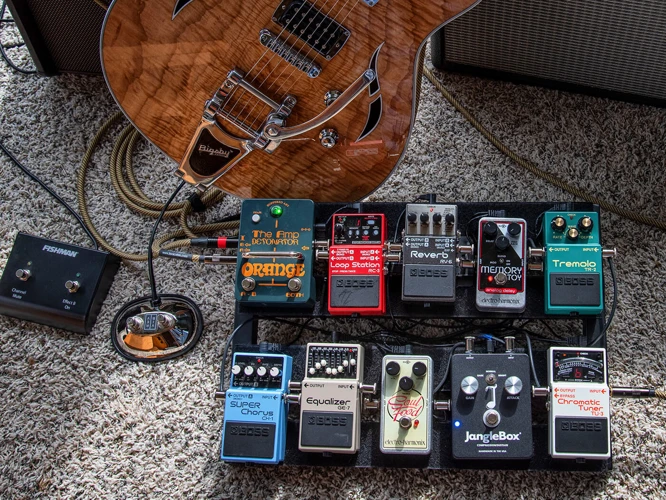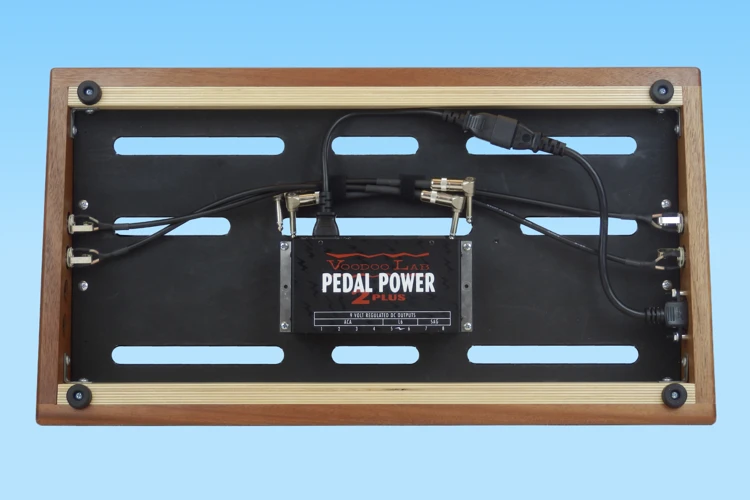Country music has a rich history and a distinctive sound, with a focus on storytelling and traditional instruments like the guitar, pedal steel, and fiddle. If you’re a country musician looking to build your own pedalboard, you’ll want to choose effects that complement the genre’s twangy, rootsy vibe. In this article, we’ll explore some essential pedals for country music and share some tips for building a pedalboard that fits your style.
Overdrive and Distortion
One of the key ingredients in country music is a warm, gritty overdrive or distortion. This effect can help you achieve the classic “tele twang” sound, as well as add some bite and attitude to your solos. Some popular overdrive and distortion pedals for country music include the Ibanez TS9 Tube Screamer, the Fulltone OCD, and the Boss SD-1 Super Overdrive.
When using overdrive or distortion, it’s important to find the right balance between grit and clarity. You want your tone to have some dirt and attitude, but you also want to be able to hear the individual notes in your chords and melodies. Experiment with different settings and pedal combinations to find the sound that works best for you.
Delay and Reverb
Delay and reverb are two other essential effects for country music. Delay can add depth and dimension to your sound, while reverb can create a sense of space and ambiance. Some popular delay and reverb pedals for country music include the Strymon Timeline, the Electro-Harmonix Memory Man, and the TC Electronic Hall of Fame.
When using delay and reverb, it’s important to use these effects sparingly. A little bit of delay or reverb can go a long way, and you don’t want to overwhelm your sound with too much echo or ambiance. Start with subtle settings and gradually increase the effect until you find the right balance.
Compressor
A compressor pedal can help you achieve a more consistent, even tone by reducing the dynamic range of your signal. This effect can be especially useful for country music, where a consistent, steady tone is important for both rhythm and lead playing. Some popular compressor pedals for country music include the MXR Dyna Comp, the Wampler Ego Compressor, and the Xotic SP Compressor.
When using a compressor, it’s important to find the right balance between sustain and punch. You want your tone to have a nice, even sustain, but you also want to be able to hear the attack and punch of your notes. Experiment with different settings and pedal combinations to find the sound that works best for you.
EQ and Tone Shaping
EQ and tone shaping pedals can help you fine-tune your sound and make sure that your tone cuts through the mix. These effects can be especially useful for country music, where a clear, defined tone is important for both rhythm and lead playing. Some popular EQ and tone shaping pedals for country music include the Boss GE-7 Equalizer, the MXR 10-Band EQ, and the EarthQuaker Devices Tone Job.
When using EQ and tone shaping pedals, it’s important to use these effects subtly. A little bit of EQ can go a long way, and you don’t want to overdo it and end up with a harsh, brittle tone. Start with subtle settings and gradually increase the effect until you find the right balance.
Loop Switchers and Multi-Effects
If you’re building a more complex pedalboard, you may want to consider using a loop switcher or a multi-effects pedal. These devices allow you to organize your pedals into different loops, which can be turned on and off individually or in combination. This can be a great way to streamline your pedalboard and make it easier to switch between different effects and settings.
Some popular loop switchers and multi-effects pedals for country music include the Boss ES-8, the Electro-Harmonix Switchblade, and the Line 6 Helix.
Power Supplies and Cables
When building your pedalboard, it’s important to consider the power supplies and cables you’ll need to connect everything. A good power supply will provide clean, stable power to all of your pedals, while high-quality cables will ensure that your signal is clear and free from noise.
Some popular power supplies for pedalboards include the Voodoo Lab Pedal Power 2+, the Truetone 1 Spot, and the Cioks DC7. For cables, consider using high-quality shielded cables like the Mogami Gold or the George L’s.
Building Your Pedalboard
When it comes to building your pedalboard, there are a few key things to keep in mind. First, consider the order of your pedals. In general, it’s best to place your overdrive and distortion pedals towards the beginning of your signal chain, followed by your delay and reverb pedals. Compressors and EQ pedals can be placed anywhere in the chain, depending on the sound you’re going for.
Next, think about the layout of your pedalboard. You’ll want to arrange your pedals in a way that makes sense for your playing style and allows you to easily access all of your effects. Consider using a pedalboard mat or a pedalboard case to protect your pedals and keep everything organized.
Finally, don’t be afraid to experiment and try new things. Building a pedalboard is a personal process, and what works for one musician may not work for another. Have fun and enjoy the process of finding your own unique sound.
Looking to enhance your country music sound? Check out our articles on mastering fingerstyle techniques, choosing the best pedal effects, guitar pedals for country music, country guitar sliding techniques, and hybrid picking for country guitar to help you build the perfect pedalboard for your country music setup!
Conclusion
Building a pedalboard for country music can be a rewarding and creative process. By choosing the right effects and organizing them in a way that makes sense for your playing style, you can create a unique, distinctive sound that sets you apart from other musicians. Whether you’re a beginner or a seasoned pro, there’s always something new to learn and explore in the world of pedals and effects. So get out there, have fun, and start building your dream pedalboard today!



